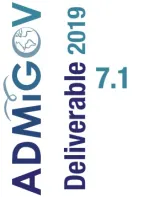Measuring ‘Good’ Migration Governance in Turbulent Times, a Critical State of the Art

ADMIGOV (Deliverable 7.1)
The scope, intensity and fast-changing nature of contemporary international mobility is putting strain on systems of migration governance, drawing attention to their limits and contradictions. A series of emergencies over the last few years have led the international community to critically assess the governance of international migration in its entirety. This assessment has called into question both the driving principles and operational strategies of international migration governance. The 2016 New York Declaration (NYD), the later 2018 Global Compacts on Migration and Refugees, but also the wider 2015 Sustainable Development Goals (SDGs), have mirrored such reasoning. These international agreements share key-goals to be pursued in relation to migration governance, including: upholding the fundamental rights and freedoms of refugees and migrants; enhancing humanitarian efforts to save lives and offer adequate short, medium and long-term protection; strengthening the connection between different levels of government and support and improving the cooperation between actors involved in the global governance of migration; and tackling the “root causes” of human mobility in their political, social and economic dimensions. The SDGs, the NYD and the Global Compacts call for new solutions and alternative approaches to migration governance, able to realize such goals.